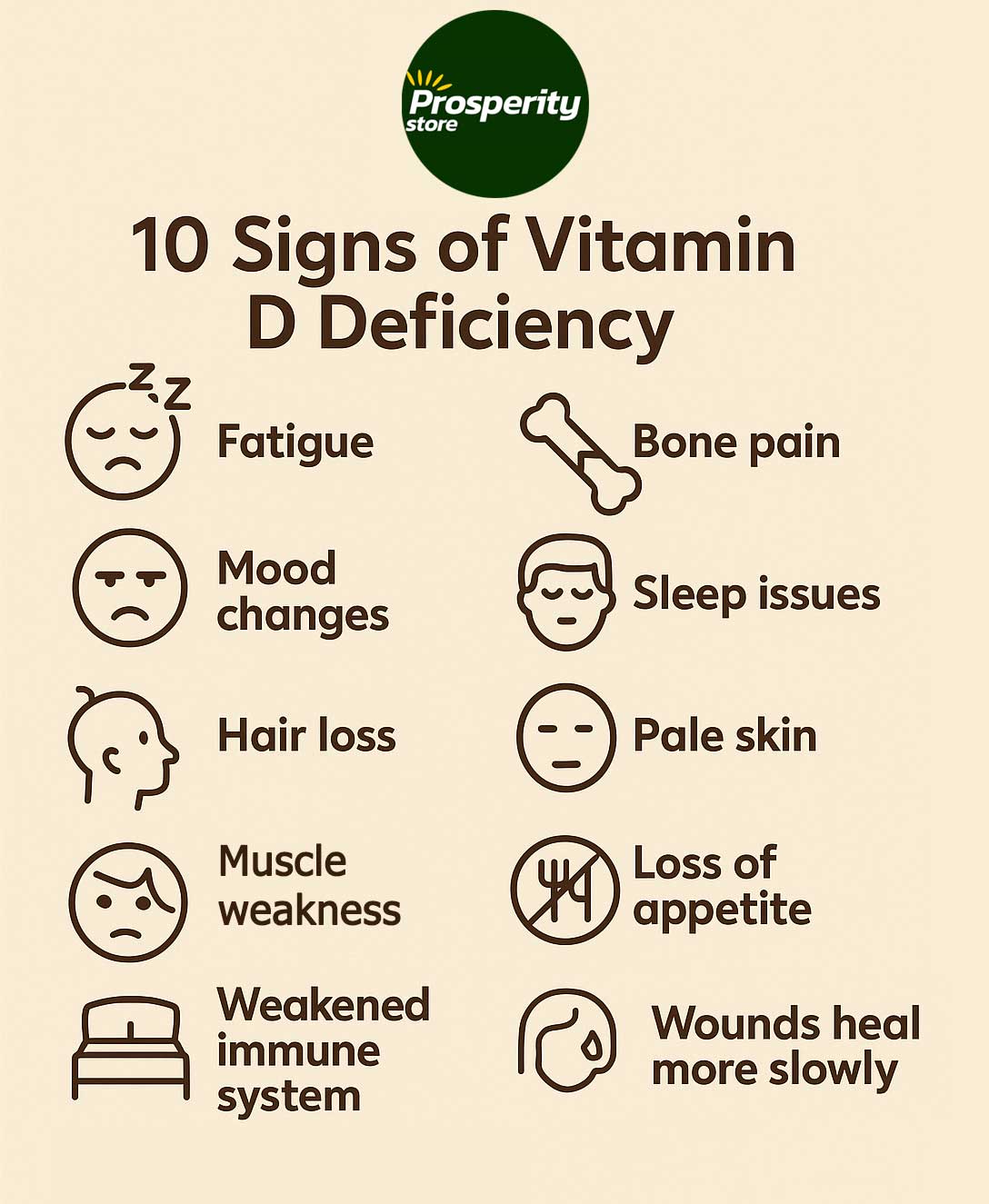10 Vitamin D Deficiency Symptoms
Summarize

Low vitamin D and vitamin D deficiency are terms that refer to the degree to which there is not enough vitamin D in your body. A deficiency is more severe than a low level, but both can cause health issues. There are signs of vitamin D deficiency, such as bone pain and muscle weakness. Fortunately, a simple blood test administered by a doctor can help identify vitamin D levels, and supplementation can help restore balance.
Signs of Vitamin D Deficiency
There are many well-documented benefits of vitamin D. It helps with calcium absorption, which is needed to maintain healthy bones. It supports nerve functioning for muscle movement. Vitamin D also supports the immune system. It does so by helping the body fight off viruses and bacteria.
There is now a debate within the medical community about what constitutes low and deficient vitamin D levels in blood samples.
📜
Currently, the U.S. National Academy of Medicine recommends that adults aged 19 to 70 take 600 IU daily, and then 800 IU after age 70.
This is just a general guideline. Your doctor will determine the proper amount and schedule of vitamin D supplementation based on a blood test.
Can low vitamin D cause fatigue? Do you develop muscle weakness with low vitamin D? Can my lower back pain be due to low vitamin D? These are common questions people ask about vitamin D, as early symptoms may not be associated with it.
The following are 10 signs of low vitamin D or a vitamin D deficiency.
1. Fatigue or experiencing low energy, even after resting.
2. Muscle weakness or cramping, especially in the lower back or legs.
3. Bone pain or aching joints, including in the lower back, due to poor bone health.
4. Mood changes that include feeling sad, irritable, or depressed.
5. Trouble falling or staying asleep.
6. Vitamin D deficiency hair loss or thinning.
7. Pale skin.
8. Loss of appetite.
9. Weakened immune system, so an individual gets sick more easily and frequently.
10. Wounds heal more slowly.
📜
Postmenopausal women have a higher risk of a vitamin D deficiency.
This contributes to osteoporosis and a higher risk of bone fractures. If you have low vitamin D, muscle function may also be impaired, which can contribute to falls.
A severe vitamin D deficiency leads to low calcium levels so low that they can produce nerve sensations like “pins and needles”. Children develop soft, weak bones that can be painful, and they may develop skeletal deformities, such as bowed legs. Most children and adults in the U.S. have low vitamin D levels or a mild deficiency, rather than a severe deficiency.

Who’s at Higher Risk of Low Vitamin D?
Some people have a higher risk of developing low vitamin D levels.
- People who do not get at least 20 minutes of sunshine each day with at least 40% of their skin exposed.
- Dark skinned people.
- Older people (over the age of 65).
- People who use heavy sunscreen every time they are in the sun.
- People with chronic liver or kidney conditions.
- People taking certain medications that speed up the degradation of vitamin D into inactive metabolites, such as cholesterol, steroid, and weight loss medicines.
- People who have difficulty absorbing food nutrients.
- People with hereditary vitamin D resistance.
- People who have had weight loss surgery.
- People who are obese have a higher risk because fat cells bind to vitamin D, preventing the nutrient from reaching the blood.
How to Confirm Your Vitamin D Level?
A blood test is used to measure vitamin D levels. A common vitamin D deficiency test is the 25-hydroxyvitamin D. It measures the total vitamin D in your blood, which is vitamin D2 from food and vitamin D3 from sun exposure combined. There are four possible results.
| Level | Description |
|---|---|
| Deficiency | Low vitamin D may affect bones, muscles, and general health, but may not produce symptoms. |
| Insufficiency | Very low vitamin D levels are likely to affect bones, muscles, and overall health. |
| Sufficiency | Vitamin D levels are good and support general health. |
| Toxic | Very low vitamin D is likely to affect bones, muscles, and general health. |
What Are the Main Causes of Deficiency?
What are the causes of vitamin D deficiency?
- Your diet does not supply enough vitamin D.
- You have a malabsorption issue that prevents your body from absorbing vitamin D from foods.
- You do not get enough sunlight exposure.
- Your kidneys or liver are not functioning correctly, so vitamin D is not converted into an active form.
- Some medicines impede the body’s ability to convert vitamin D or prevent absorption.
FAQs
Can I get enough Vitamin D from the sun alone?
Theoretically, it is possible to get enough sun exposure to produce the vitamin D needed for good health. The issue is that staying in the sun too long can cause skin cancer. It is all about balance.
Also, if you are on certain medications that interfere with vitamin D production or have health issues that interfere with vitamin D absorption, you would not get enough vitamin D from sun exposure alone.How long does it take to raise low vitamin D?
The time it takes to raise a low vitamin D level depends on how low the starting level is and your personal characteristics, such as weight, diseases, or conditions that interfere with vitamin D absorption, and the supplement dosage.
The National Center for Biotechnology Information recommends that individuals with a vitamin D deficiency start by taking high-potency vitamin D supplements (prescription may be required) once a week for 8 weeks. Then a daily maintenance dose is taken. If you have low vitamin D levels, start by taking a daily over-the-counter supplement. Your doctor determines the dosage amount.What’s the best time of year to test for vitamin D?

Winter is typically the season when vitamin D deficiency and insufficiency are most prevalent. Research has shown this is true for people of all ages. The end of winter is the best time of year to test for vitamin D. It is also recommended that a doctor test at the end of winter and at the end of summer to identify seasonal changes in vitamin D levels for comparison.Can I take too much vitamin D?
Yes, there is such a thing as vitamin D toxicity. Vitamin D toxicity can create an imbalance in your bone metabolism and lead to an excessively high level of calcium in the blood. Symptoms include vomiting, an upset stomach, weakness, bone pain, and kidney issues.
Maintaining Vitamin D Levels Throughout Life
Maintaining healthy vitamin D levels is important throughout your lifetime. Vitamin D is crucial for maintaining good health for so many reasons. Some people can obtain the recommended amount of vitamin D through a balanced diet and adequate sun exposure. This is challenging as you age, develop medical conditions, and take medications. The good news is that managing vitamin D levels is easy through routine testing and supplementation. Knowing the signs of low vitamin D and working with your doctor will ensure you maintain the right level for healthy muscles, bones, and nerves.
Sources
- https://www.jwatch.org/na57804/2024/08/14/vitamin-d-preventing-disease-new-guideline
- https://ods.od.nih.gov/factsheets/VitaminD-HealthProfessional
- https://pmc.ncbi.nlm.nih.gov/articles/PMC7278294/#section12-2042018820931291
- https://www.ncbi.nlm.nih.gov/books/NBK532266/
- https://medlineplus.gov/lab-tests/vitamin-d-test/
- https://medlineplus.gov/vitaminddeficiency.html
- https://www.ncbi.nlm.nih.gov/books/NBK532266/#article-31224.s8
- https://pmc.ncbi.nlm.nih.gov/articles/PMC5346786/#j_jomb-2015-0014_s_004
- https://www.ncbi.nlm.nih.gov/books/NBK557876/
Share this post
